INDONESIA
Economy

Economy
Cities in INDONESIA
| Jakarta | Yogyakarta |
Popular destinations INDONESIA
| Bali | Java | Sumatra |
Economy
General
The economy of Indonesia is dominated by the geographically unequal distribution of the population and by the pattern of production-consumption, with major economic conflicts of interest growing between the overpopulated consuming Java and the sparsely populated, foreign-producing so-called outer regions, the outer Javanese islands.
The difficulties associated with this situation have been exacerbated by the political tensions, the nationalisations of 1957 and subsequent years, the large military expenditures, and the quite expensive administrative costs.
From 1988 to mid-1997, Indonesia experienced a strong economic recovery (annual per capita income increased from $ 75 in the 1960s to $ 1,000 in the 1990s), mainly thanks to a policy of liberalization, aimed at, among other things, reduce dependence on oil revenues and build a more differentiated economy.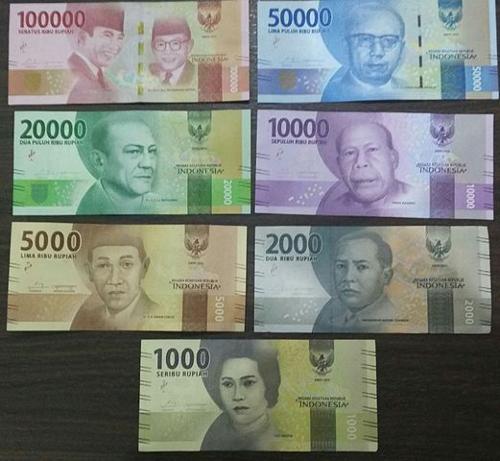 Indonesian banknotesPhoto: Beeyan CC 3.0 Unported no changes made
Indonesian banknotesPhoto: Beeyan CC 3.0 Unported no changes made
The government's economic policy promotes the export of various (processing) industries, especially wood products. The favorable results of this are mainly due to the help of large international financing organizations and development aid.
The export-oriented processing industry is currently the engine of the economy, but foreign investment in the country itself also increased. However, the Indonesian economy remains vulnerable due to dependence on foreign countries, rapid population growth (unemployment), large income disparities and the authoritarian, anti-democratic nature of the country.
At an inflation rate of approximately 10%, economic growth of approximately 7% per year will be achieved in the mid-1990s. From mid-1997, a major currency crisis ensued as a result of the financial and economic crisis in Southeast Asia, forcing the government to call in the assistance of the IMF. The rupiah exchange rate fell by more than 70% in 1997, inflation rose sharply (1998 58% !, 1999 20%, 2000 9.35%, 2001 12.55%) and hundreds of thousands of Indonesians lost their jobs (1998 15 , 5%). In the course of 1998 the rupiah exchange rate recovered somewhat, but the unstable political situation meant that there was still no structural economic recovery. That year saw negative economic growth of 13.2% due to all the problems. Only the agricultural and utilities sectors still showed positive growth. The construction sector shrank by more than 40%, making it the absolute frontrunner. From 1999 things went in the right direction again; in 1999 a growth of 0.22%, in 2000 4.8%, in 2001 3.3%, in 2002 3.66% despite the consequences of the terrorist attack on Bali in October.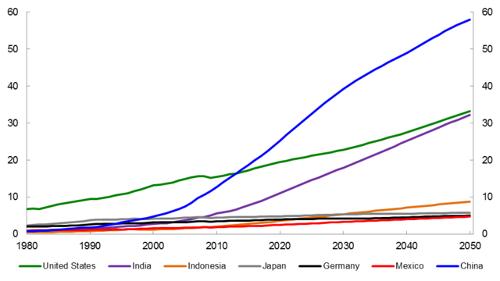 Gross domestic product development (in trillions of dollars) of various countries, including IndonesiaPhoto: Asiancentury CC 4.0 International no changes made
Gross domestic product development (in trillions of dollars) of various countries, including IndonesiaPhoto: Asiancentury CC 4.0 International no changes made
The crisis has pushed an estimated 17 million Indonesians below the poverty line. This increased the total number of people below this limit to more than 55 million, or more than a quarter of the population. Now that the economy is picking up again, it may be expected that some of these 17 million people will quickly return to above the poverty line, but for the majority of these, this process can take a long time.
Some current figures about the economy of Indonesia are that the growth rate of the economy has been around 5% in recent years. Economic growth was 5.1% in 2017. GDP per capita was $ 12,400 in 2017, with a sharp increase per year in recent years. 10.9% of the population lives below the poverty line.
Agriculture, cattle breeding, forestry and fishing
Almost 32% of the labor force is employed in agriculture (2017). Approximately 72% of the estimated 180,000 km2 of cultivated land is used for food crops and the remainder for commercial crops. In 2017, 13.7% of the gross domestic product was accounted for by the agricultural sector. A strong agricultural sector is expected to lead to greater prosperity in the countryside.
The main food crops are rice, maize, cassava and sweet potatoes, groundnuts, soybeans, copra and sugar. The rice culture is the oldest and predominant culture, for the most part on paddy fields, but also (outside Java) on dry, annually changing fields (ladang cultivation: form of agriculture in which a crop is planted in a piece of forest that was first burned to the ground). After the rice harvest, second crops are often grown without irrigation. Since rice cultivation is very important for food supply and it is equally important for public finances to become independent from rice imports, attempts have been made to increase food production, but initially did not lead to the expected results.
The country is now predominantly self-sufficient. Agricultural reforms, use of fertilizers, control of insect pests and diseases have led to quality improvements, as have the introduction of new varieties. This not only increased the yield per plot, but it was also possible to harvest two to three times a year.
Rice is the main crop in Western Indonesia due to its favorable climate. In East Indonesia, corn is the staple food, while sago is the main food crop in the Moluccas and Irian Jaya.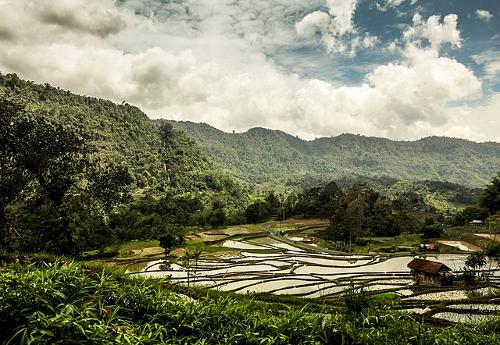 Mountains and rice fields or paddy fields in Ciwidey, West Java, IndonesiaPhoto: Cocakolam CC 4.0 International no changes made
Mountains and rice fields or paddy fields in Ciwidey, West Java, IndonesiaPhoto: Cocakolam CC 4.0 International no changes made
The main commercial crops are rubber, palm oil, tobacco, tea, copra, coffee (the second largest world producer after Brazil and Colombia), cocoa, pepper and other spices. The cultivation takes place mainly in Sumatra and Java, either on large cultural enterprises or, as in rubber production, by small farmers. Indonesia is the second largest world producer of rubber after Malaysia.
The krètèk cigarette industry has undergone rapid growth in recent decades, which in turn was beneficial for clove cultivation (cloves or cengkèk). A krètèk cigarette consists of tobacco mixed with coarsely ground cloves. Much of the production is still done by hand. The machine-made cigarettes are intended for the foreign market.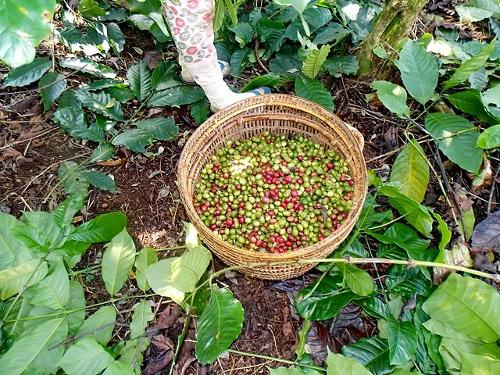 Basket with coffee beans from Pagaralam, South Sumatra, IndonesiaPhoto: Susansumi CC 4.0 International no changes made
Basket with coffee beans from Pagaralam, South Sumatra, IndonesiaPhoto: Susansumi CC 4.0 International no changes made
Horticulture is for the most part practiced on yard crops, that is to say on yards around the houses: vegetables, fruit, herbs and spices are consumed on the spot and only a small part goes to the market.
Special horticultural companies, for cabbage varieties, beans and leeks in the mountain regions and for leafy vegetables in the lower areas, supply exclusively for the market.
The floriculture sector is still moderately developed, but focuses on seedlings, potted plants and western and tropical plants.
The development of livestock farming has lagged behind the rest of the economy in Indonesia, despite a policy of stimulus from the government. Livestock farming is mainly used to keep draft animals such as cattle, buffaloes and horses; for consumption are goats, sheep, chickens and cows. These pigs are mainly intended for export, because the vast majority of the population consists of Muslims.
Almost two thirds of the country is covered by tropical jungle (60% of Sumatra, 77% of Kalimantan and 80% of Irian Jaya), which is almost completely controlled by the state. However, concessions have also been granted to American, Filipino and Japanese carriers. Indonesia thus owns the largest rainforest in the world after Brazil and is the largest timber exporter to Southeast Asia. Sawn wood, plywood and veneer are mainly exported to Japan, South Korea, Singapore, Taiwan and Australia.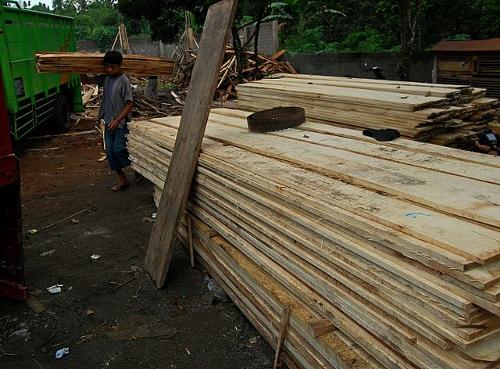 Candlenut (Aleurites moluccana), sawn timber, Narmada, Lombok, IndonesiaPhoto: Wibowo Djatmiko (Wie146) CC 3.0 Unported no changes made
Candlenut (Aleurites moluccana), sawn timber, Narmada, Lombok, IndonesiaPhoto: Wibowo Djatmiko (Wie146) CC 3.0 Unported no changes made
Besides wood, the forests also supply resins and gums, turpentine, rattan and kajapoetih oil. The marrow extracted from the sago palm is the folk food on Irian Jaya. Sometimes drought and irresponsible logging, especially in Sumatra, Kalimantan and Irian Jaya, cause persistent forest fires.
Fishing is very important for the food supply in Indonesia, although due to a lack of fishing boats and knowledge among the fishermen, only a small part of the potential is used. The fishing sector is dominated by very small-scale fishing companies. Fishing takes place with sailing prowls, whether motorized or not, as well as with séros, giant traps with bamboo stakes.
Particularly along the coasts of Sulawesi and Kalimantan, in the Riau Archipelago and in Maluku, some population groups live almost exclusively from fishing. In some regions of Java, fish is released in the wet rice fields and further, especially along the north coast of Java, there are separate fish and shrimp ponds; more than half of the fish caught is supplied by these artificial fish ponds.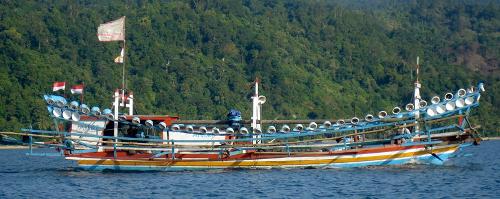 Fishing boat in Sumatra, IndonesiaPhoto: James Gagen CC 2.0 Generic no changes made
Fishing boat in Sumatra, IndonesiaPhoto: James Gagen CC 2.0 Generic no changes made
Sea fisheries, including shrimp exports, have advanced significantly over the 1980s through modernization of the fishing fleet and improved fishing techniques.
The main products for the fishing industry are bottom fish, deep sea fish, skipjack, tuna, squid, shrimp, weever, Indian squid and seaweed. The largest buyers are Japan and the United States.
Mining and energy supply
Indonesia is the second largest tin producer in the world after Malaysia, and its resources have hardly been explored or mapped. The main problem is the (in) accessibility of the locations where the minerals and metals are in the ground, often densely forested or mountainous areas.
Petroleum is found in East and South Sumatra, in East Kalimantan and East Java, but also off-shore. The operation is partly in the hands of private companies, partly in the hands of the state-owned company Pertamina.
Indonesia is Southeast Asia's largest petroleum producer and remains the main source of hard currency and tax revenue.
Natural gas is mainly found in the Natuna Islands in the South China Sea and South Sumatra and East Kalimantan.
Other mineral resources mainly include tin (in 2001 62,000 tons on Bangka, Billiton and Singkep in the Riau Archipelago), bauxite (Riau Islands), nickel (South Sulawesi; almost everything is exploited), coal (South and Central). -Sumatra) and iron ore (Irian Jaya). Gold, silver and copper are also mined. Almost all exploration and exploitation activities are carried out by foreign mining companies, sometimes in the form of joint ventures with Indonesian companies.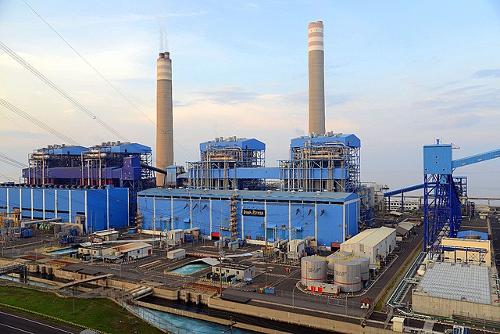 PT Jawa Power, a 1,220 MW Coal-Fired Power Plant located in Paiton complex, East Jawa, IndonesiaPhoto: YTL Power International Berhad CC 4.0 International no changes made
PT Jawa Power, a 1,220 MW Coal-Fired Power Plant located in Paiton complex, East Jawa, IndonesiaPhoto: YTL Power International Berhad CC 4.0 International no changes made
More than half of the total energy supply comes from petroleum or gas-fired power stations. Hydropower, geothermal energy and especially coal are also important energy sources.
Industry
In fact, the development of the industrial sector only flourished from the mid-1960s. From time on, the government put less and less money into industrial development, while at the same time creating a liberal investment climate for domestic and foreign private investors.
The industry is mostly concentrated on Java. More than half of this consists of small and medium-sized companies, about half of which are mechanized. Approximately 85% of the larger companies is mechanized; this sector includes shipbuilding, petroleum refining, chemical industry, textile, cement, paper and fertilizer manufacturing. There are also companies manufacturing electronic equipment, cars and airplanes.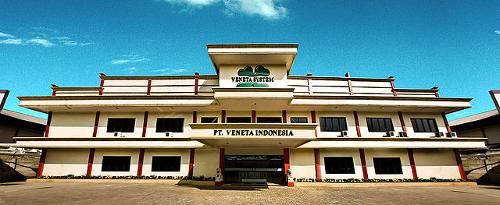 Veneta System factory, Jakarta Indonesia, among other things makes tonerPhoto: Veneta System CC 4.0 International no changes made
Veneta System factory, Jakarta Indonesia, among other things makes tonerPhoto: Veneta System CC 4.0 International no changes made
The share of manufacturing industrial production in GDP has increased from 8.5% in 1970 to 41% in 2017.
An increasingly important share in the domestic industry is claimed by manufacturers of shoes, electronics and textiles. This mainly concerns globally operating companies from countries such as Japan and South Korea, which are benefiting from the low wages in Indonesia. As a result, the apparel and textile industry has grown over the past decade to become the second most important sector in terms of foreign exchange earnings.
Trade
The trade balance has been positive since 1980 (declined to $ 18 billion in 2017).
From the mid-1970s, Indonesian exports were dominated by exports of oil and natural gas. In the mid-1980s, exports of these products rose to more than three-quarters of Indonesia's total export earnings. Then came a policy to reduce dependence on oil and gas and focus more on the development of the industry. Already in 1987, the share of oil and gas exports declined quite sharply.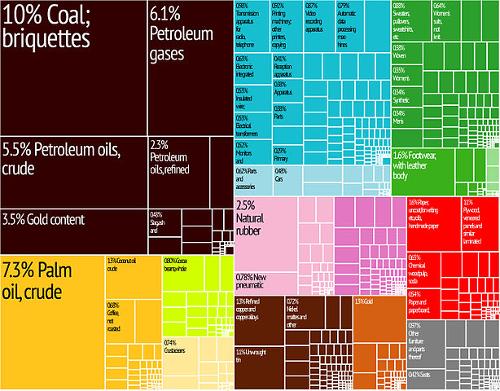 Overview of export products IndonesiaPhoto: R. Haussmann, Cesar Hidalgo, et.al. CC 3.0 Unported no changes made
Overview of export products IndonesiaPhoto: R. Haussmann, Cesar Hidalgo, et.al. CC 3.0 Unported no changes made
The main export products, apart from oil and gas, are traditionally commodities: rubber, coal, tin, tobacco, coffee, tea, palm oil and copra, as well as plywood, clothing and textiles, footwear, wood, fish and shrimp.
Imports mainly consist of transport and food, chemicals and capital goods.
Indonesia trades most with China, Japan, the United States and Singapore. Traditionally, the Netherlands has also played a role, which is also rapidly shrinking.
Sources
Dalton, B. / De Indonesië reisgids
Elmar
Darmawie-van Oijen, J. / Indonesië : handboek voor reizigers
Babylon-De Geus
Homburg, E. / Indonesië
Elmar,
Indonesië
Cambium
Lyle, G. / Indonesia
Chelsea House
Martyr, D. / Indonesië
Van Reemst
Mastenbroek, B. / Kijk op Indonesië
Elsevier
Muller, K. / Indonesië : het 13.000 eilandenrijk
Becht
Oosterman, I. / Indonesië
ANWB Media
Schulte Nordholt, N. / Indonesië : mensen, politiek, economie, cultuur
Koninklijk Instituut voor de Tropen / NOVIB
Te gast in Indonesië
Informatie Verre Reizen
Wassing, R. S. / Indonesië : Java, Bali, Lombok, Sumbawa, Komodo, Flores, Sumba, Timor, Sumatra, Zuid- en Oost-Kalimantan, Sulawesi, Singapore
Gottmer
Witjes, B. / Indonesië
Stichting Teleac
CIA - World Factbook
BBC - Country Profiles
Copyright: Team The World of Info